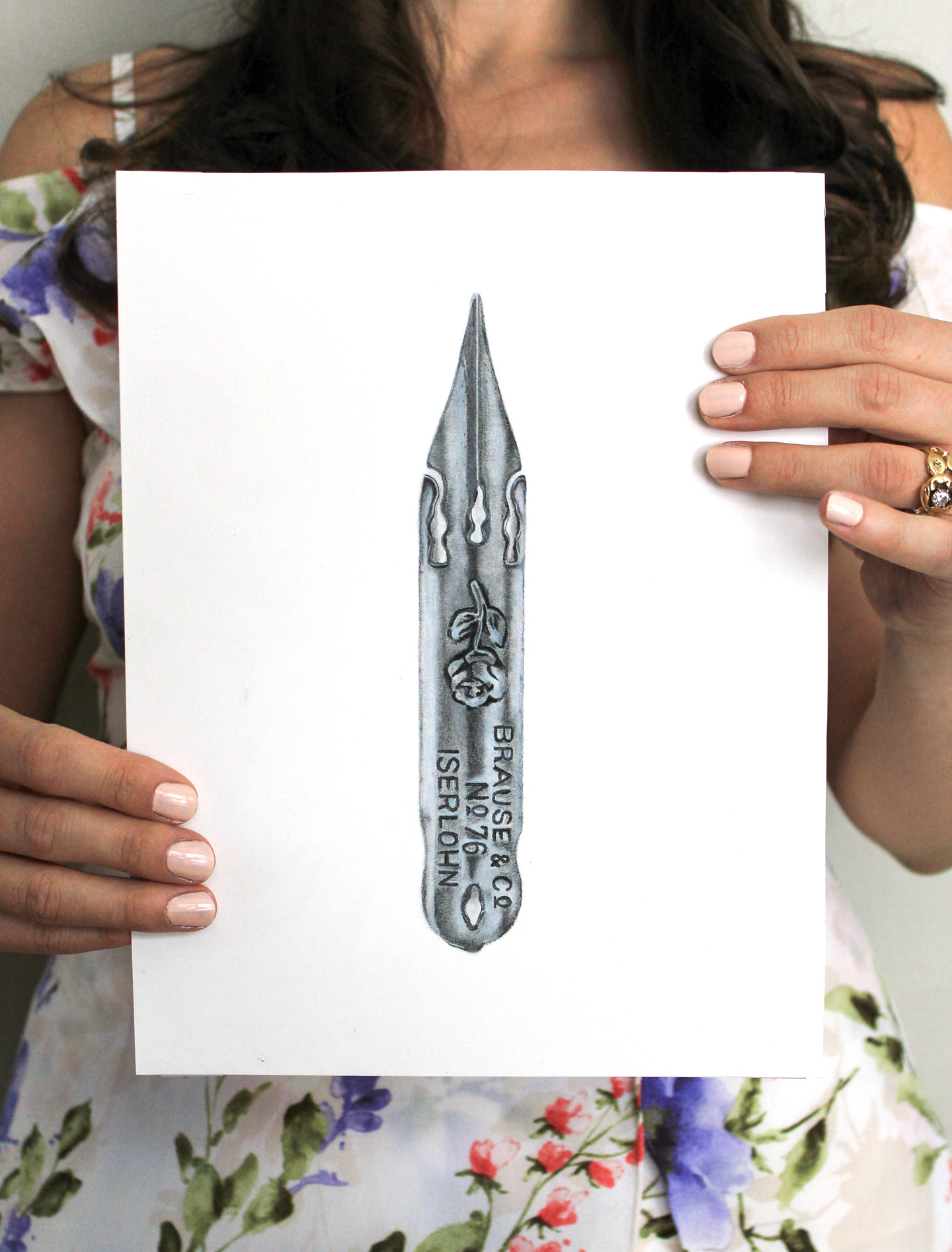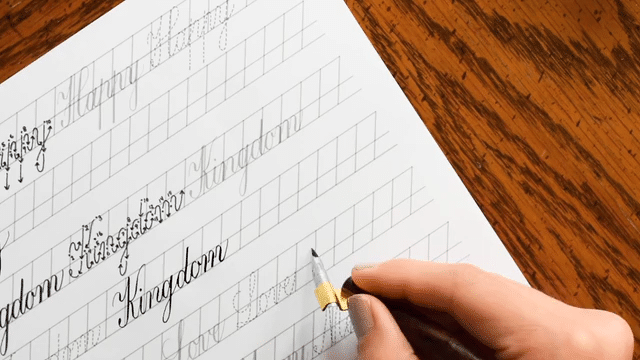
If you’re a calligraphy beginner, then you’ve probably made a couple of the mistakes listed below. And that’s not a bad thing! Blunders make us much better at any skill … once you do something the wrong way, it’s easier to do it the right way the second time around. Still, it’s more convenient to learn from others’ mistakes before you make your own! That’s why I’ve compiled this list of the six things that seem to trip calligraphy beginners up the most!
1. Using Flexible Nibs
Flexible nibs — nibs with tines that spread apart easily (like the Brause Rose, pictured below) — are awesome. Flexibility translates into great stroke contrast, so your calligraphy will feature a mix of gorgeous thick strokes and delicate thin strokes.

At the same time, flexible nibs can be very temperamental for a calligraphy beginner. The tines’ ability to spread apart so easily also means that they catch on paper easily, which results in ink spatters! Furthermore, it can be tough to regulate ink flow with flexible nibs because sometimes the tines spread too far apart and prevent ink from flowing. That’s why I believe it’s best to ease in to flexible nibs by starting with a strong nib. My very favorite nib for beginners is the Nikko G!

The Nikko G is a Japanese nib that was originally developed for manga artists. Its tines aren’t as flexible as some other nibs, but that’s a good thing! The Nikko G’s strong build means that it will stay tolerant and effective as you work out the kinks with holding the nib at the correct angle and alternating pressure application.

Despite its moderate flex, the Nikko G nib is capable of making great stroke contrast once you get comfortable with using it. The 2013 Kaitlin Style wedding suite shown above was one of the first things I made with the Nikko G, and you can see that there’s a good mix of thick downstrokes and thin upstrokes. If you’re a calligraphy beginner and you don’t have the Nikko G nib, I entreat you to try one! It was a complete game changer for me, and I know that you’ll feel the same way. You can find a list of where to buy the Nikko G in a variety of different countries in the Ultimate Modern Calligraphy Starter Kit post.
2. Not Preparing New Nibs for Use
When you buy new nibs, it’s reasonable to assume that they are ready to use. However, this is not the case. If you’re a longtime reader, this is probably the millionth time you’ve heard this, but here I go again: new nibs have pesky oils on them that need to be removed.

Why are oily nibs an issue? Well, because the oil reacts with your ink (which is often water-based), and will affect ink flow. If you haven’t cleaned your new nib, ink will likely form little beads on the nib that have no intention of traveling down to the paper. That can be frustrating and discouraging for any calligraphy beginner! So, as soon as you get your nib/s, clean the oils off! You can do this in a variety of ways, but my favorite method involves sticking the nib into a potato.

Wait for fifteen minutes, take the nib out, and wipe it off! The oils should now be gone from the nib. If the concept of sticking the nib into a potato is a bit mystifying, you can check out this video for a 45-second nib cleaning tutorial.
3. Holding Your Dip Pen Like a Regular Pen
Holding a regular pen or pencil involves a lot of finger work. Mainly, you use your thumb, index, and middle finger to navigate the pen — and, of course, that gives you good results.

Many calligrapher beginners jump into writing with a dip pen the same way that they write with a regular pen. That is to say: you curl your hand around the pen, and try to use only your fingers to move the pen up and down. The problem with that is this: dip pens don’t take well to upright angles.

If you hold your dip pen like you hold a regular pen, you’ll have issues with ink flow and the nib catching on paper. It will also be difficult to create nice stroke contrast. Instead, try to hold your pen as shown above. Keep a nice, loose grip and incorporate your wrist and arm into writing! To learn more about how to hold a calligraphy pen, you can reference this blog post.
4. Writing on Difficult Paper
When I was a calligraphy beginner, I assumed that I could write on any piece of paper. When ink soaked into paper and spiderwebbed out, I just knew it was user error — which is actually not the case!

If you try writing on certain brands of standard printer paper and card stocks, you’ll find that ink tends to creep out around the edges of letters. While the Janet Style calligraphy pictured above is nice, it loses a lot of its elegance and professionalism because of the ink bleeding. To prevent that, use a high-quality paper with tight fibers. For practice, I recommend 32# laserjet paper. For more formal artwork, try 80# drawing paper or watercolor paper.
5. Not Cleaning Nibs as You Write
When you sit down to write calligraphy, make sure you have a nice, full cup of water beside you. This water isn’t for drinking — it’s for cleaning off your nib!

As you write, you’ll find that ink dries on the nib fairly quickly. Even if you dip the nib in ink repeatedly, that dried ink will mess with the new ink and create ink flow issues. To avoid that, try wiping off your nib every couple of minutes with water and a cloth. (For more information on the cleaning process, you can reference this blog post.) Ideally, you should dip your nib in ink, write for a couple of minutes, clean the nib off with water, write for a couple more minutes … and the cycle repeats!
6. Giving Up Too Early
Here’s the most important thing to remember: nobody starts out being good at calligraphy. After I first tried a dip pen, I abandoned it for years because it was too difficult to use. And that was a shame! With some practice, I could have discovered something that I really enjoy a little bit earlier.

I don’t have any awful examples of my first-attempt calligraphy pieces. That’s not because they didn’t exist — they certainly did! It’s just that I threw away the stuff I didn’t like a long time ago. What I can show you is the photo above: a faux calligraphy piece that I made for my mom in 2011. It’s not bad at all for a beginner, but if you compare it to my contemporary calligraphy, there’s a night and day difference! The point is: if ever you feel discouraged, take a couple of days off, then try again. There will be days where you tell yourself that you just don’t have a knack for dip pen calligraphy. You do! Write drills, fill out worksheets, and make projects like mail art, and you’ll start to notice improvement with every calligraphy piece that you create.
I hope that this blog post helps you to identify some things that may have been holding you back with your calligraphy! Of course, if you have any questions about beginner calligraphy, I’m happy to answer them in the comments. Thank you so much for reading TPK, and have a wonderful weekend!
Warmly,

*This post contains affiliate links to Amazon














